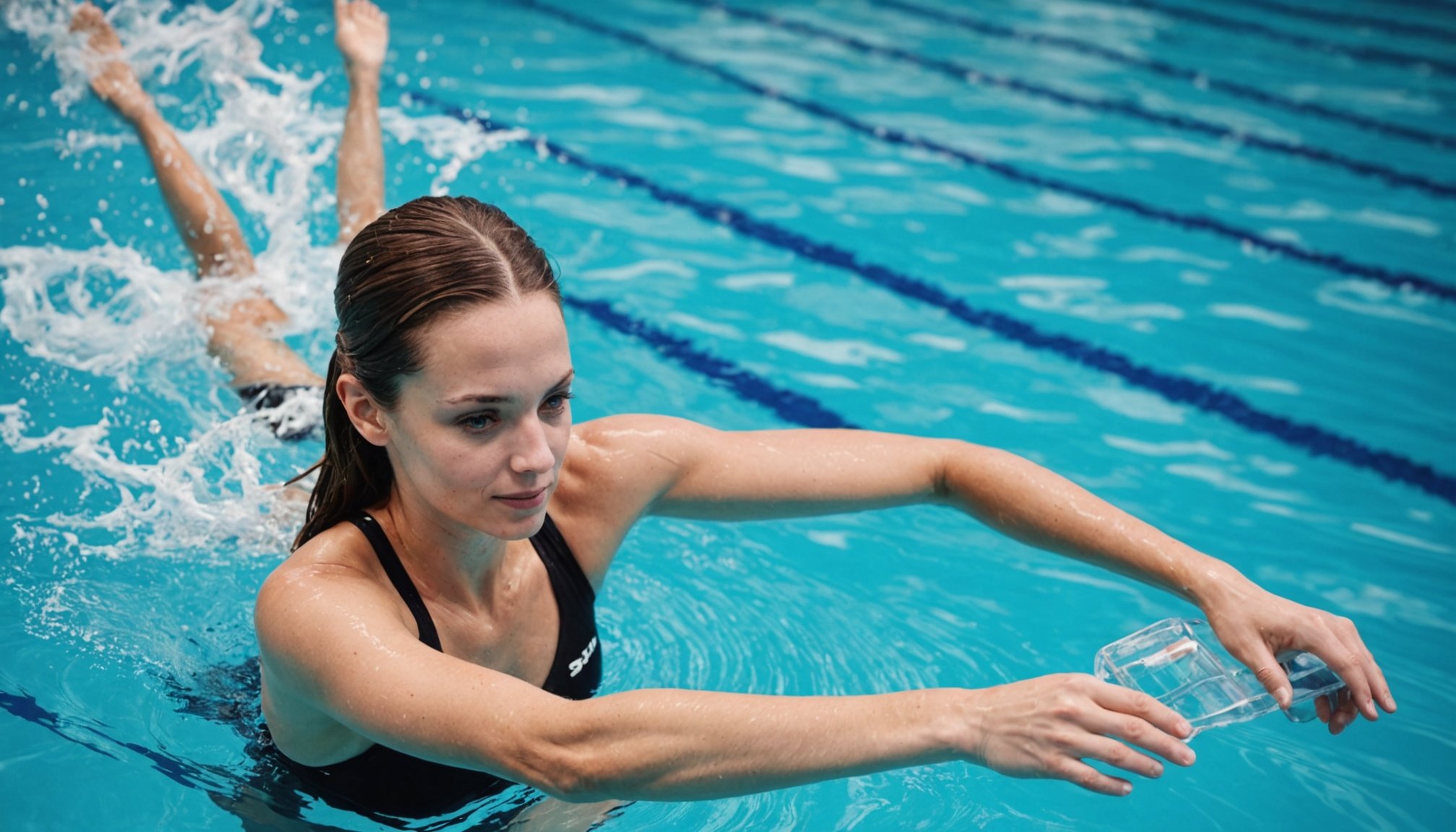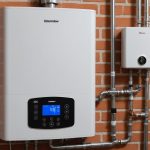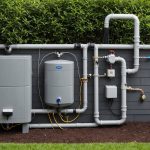Top Techniques for Effectively Balancing pH Levels in Your UK Home Swimming Pool
Maintaining the perfect pH levels in your swimming pool is crucial for a safe, enjoyable, and healthy swimming experience. Here’s a comprehensive guide to help you understand and manage the pH balance of your pool water.
Understanding Pool Water Chemistry
Before diving into the specifics of pH balance, it’s essential to grasp the broader concept of pool water chemistry. The quality of your pool water hinges on balancing several key chemicals, including chlorine, calcium, and alkalinity.
A voir aussi : Transform Your UK Home with a Stunning Mediterranean-Inspired Pool Area
Chlorine Levels
Chlorine is the most common disinfectant used in swimming pools. It comes in two forms: free chlorine and combined chlorine. Free chlorine is available to sanitize your pool, while combined chlorine has already reacted with contaminants. Maintaining the right chlorine levels is vital for effective sanitization and preventing the growth of harmful pathogens like legionella bacteria[4].
Calcium Hardness
Calcium hardness is another critical parameter. Too much calcium can cause scaling on your pool tiles and equipment, while too little can lead to corrosion. The ideal calcium hardness level is typically between 200 and 400 parts per million (ppm), depending on your pool’s materials and local water conditions[4].
Sujet a lire : Optimal Autumn Temperature Settings for Your Heated Home Swimming Pool in the UK: A Comprehensive Guide
Alkalinity
Total alkalinity acts as a buffer to stabilize the pH levels in your pool. It helps prevent sudden changes in pH, which can be harmful to swimmers and damaging to your pool equipment. Alkalinity builders, such as sodium bicarbonate, can be used to increase the alkalinity level in your pool or hot tub[3].
Testing Your Pool Water
Regular water testing is the cornerstone of maintaining balanced pool water chemistry.
How to Test Your Water
Use a reliable water testing kit to measure the current pH, chlorine, and alkalinity levels. Here are the steps to follow:
- pH Level: The ideal pH range for swimming pools is between 7.2 and 7.8. Levels outside this range can cause eye irritation and damage to your pool equipment.
- Chlorine Levels: Ensure the free chlorine level is between 1 and 3 ppm.
- Alkalinity: The total alkalinity level should be between 80 and 120 ppm[4].
Adjusting pH Levels
Once you’ve tested your pool water, you may need to adjust the pH levels.
Increasing pH Levels
If your pH level is too low, you’ll need to use a pH increaser. Here’s how to do it:
- Determine the Dose: Calculate the amount of pH increaser needed based on your pool volume and the current pH level.
- Add the Chemical: Slowly add the pH increaser to the pool water while the pump is running to ensure even distribution.
- Re-test: After a few hours, re-test the pH level to ensure it’s within the ideal range[2].
Decreasing pH Levels
If your pH level is too high, you’ll need to use a pH decreaser.
- Determine the Dose: Typically, you’ll need 10g of pH Minus Decreaser per 1,000 liters of pool water.
- Add the Chemical: Add the pH decreaser to the pool water while the pump is running.
- Re-test: Re-test the pH level after a few hours to ensure it’s within the ideal range[2].
Using Chemical Dosing Systems
Chemical dosing systems can make maintaining the right pH levels much easier and more precise.
Types of Dosing Pumps
There are several types of dosing pumps available, including peristaltic, diaphragm, piston, and solenoid pumps. Each type has its own advantages and is suited for different pool sizes and chemical dosing needs[1].
Benefits of Dosing Systems
- Precision: Dosing systems ensure precise and consistent chemical dosing, which is essential for maintaining your pool’s water quality.
- Convenience: These systems automate the process, reducing the need for manual adjustments.
- Maintenance: Regular maintenance of the dosing pump is crucial to prevent clogs, leaks, and inconsistent chemical dosing[1].
Common Mistakes to Avoid
When managing your pool’s pH levels, there are several common mistakes to avoid.
Selecting the Wrong Dosing Pump
Choosing a dosing pump that’s too large or too small for your pool can lead to inaccurate dosing, resulting in cloudy water, imbalanced pH levels, or ineffective sanitation.
How to Avoid:
- Determine your pool’s volume and the required chemical dosage before choosing a pump.
- Use sizing tools or consult a pool professional to ensure you select a pump that matches your pool’s specific needs[1].
Skipping Regular Maintenance
Skipping regular maintenance of your dosing pump can lead to clogs, leaks, and inconsistent chemical dosing.
How to Avoid:
- Establish a routine maintenance schedule that includes checking for leaks, cleaning components, and replacing worn parts.
- Regular maintenance ensures your pump operates smoothly and effectively[1].
Using Incompatible Chemicals
Using chemicals that aren’t compatible with your pump’s materials can cause corrosion, leaks, and even equipment failure.
How to Avoid:
- Always ensure that the chemicals you’re using are compatible with the materials in your dosing pump, including seals and tubing.
- Check compatibility charts or consult with a pool supply expert to avoid damage[1].
Improper Calibration
An improperly calibrated dosing pump can lead to over-chlorination or under-chlorination, making the pool water unsafe or unpleasant to swim in.
How to Avoid:
- Regularly calibrate your dosing pump based on the manufacturer’s guidelines.
- If your pool water chemistry seems off, it’s a sign that recalibration may be necessary[1].
Regular Pool Maintenance Routine
Consistency is key to effective pool maintenance. Here’s a breakdown of what you should do on a daily, weekly, and monthly basis.
Daily Checks
- Check for debris, leaves, and insects on the surface of the water.
- Use a pool net to remove these contaminants.
- Ensure the water levels are within the recommended range to avoid damaging the pool pump or affecting filtration efficiency[4].
Weekly Maintenance
- Test the water chemistry for chlorine, pH, and calcium hardness levels.
- Adjust the chemicals as needed to maintain the ideal balance.
- Clean the skimmer and pump baskets to prevent clogging and ensure efficient water circulation[4].
Monthly Maintenance
- Conduct a thorough inspection of your pool’s equipment.
- Check for any wear and tear on the pool filter, pump, and other mechanical parts.
- Lubricate moving parts and replace any damaged components promptly to prevent more significant issues down the line[4].
Practical Insights and Actionable Advice
Here are some practical tips to help you maintain the perfect pH balance in your pool:
Use Slow-Dissolving Chlorine Tablets
Using slow-dissolving chlorine tablets can help maintain a consistent chlorine level, which in turn helps stabilize the pH levels[4].
Perform Shock Treatment
Shock treatment involves adding a large amount of chlorine to your pool to eliminate contaminants. This is usually done after heavy use or if the water appears cloudy. Shock treatment helps reset your pool water back to safe chlorine levels and can help stabilize the pH[4].
Invest in Professional Maintenance
If your pool is frequently used, consider investing in professional maintenance services. Professionals can provide detailed water testing, adjust chemical levels, and perform thorough equipment inspections to ensure your pool remains in top condition[4].
Table: Ideal Pool Water Chemistry Parameters
| Parameter | Ideal Range | Importance |
|---|---|---|
| pH Level | 7.2 – 7.8 | Prevents eye irritation and damage to pool equipment |
| Free Chlorine | 1 – 3 ppm | Ensures effective sanitization and prevents pathogen growth |
| Total Alkalinity | 80 – 120 ppm | Acts as a buffer to stabilize pH levels |
| Calcium Hardness | 200 – 400 ppm | Prevents scaling and corrosion of pool equipment |
| Cyanuric Acid | 30 – 50 ppm | Stabilizes chlorine and protects it from sunlight degradation |
Quotes and Expert Insights
- “Maintaining the right chemical balance in your swimming pool is crucial for keeping the water clean, safe, and enjoyable. A chemical dosing pump is an invaluable tool for this purpose, but improper use can lead to issues that affect both the water quality and the longevity of your pool equipment.” – Go Aqua UK[1]
- “Regular water testing is essential to keep the parameters in check. You can use water testing kits available in the market, or you can opt for professional services to ensure your pool’s water chemistry is balanced.” – The Designer Dwelling[4]
- “Consistency is the key to effective pool maintenance. A regular pool maintenance routine ensures your pool remains in top condition and safe for use.” – The Designer Dwelling[4]
Maintaining the perfect pH balance in your swimming pool is a multifaceted task that requires regular testing, precise chemical dosing, and consistent maintenance. By understanding the importance of water chemistry, using the right dosing systems, and avoiding common mistakes, you can ensure a safe and enjoyable swimming environment. Whether you manage your pool on your own or seek professional help, prioritizing health safety and adhering to best practices will keep your pool in excellent condition, making it a haven of relaxation and fun for years to come.











